
Colon polyps are small growths on the inside of the colon. They develop from normal cells that have started to divide and grow at an increased rate.
Notice the raised appearance of this polyp. It's growing more quickly than the surrounding colon.
Polyps can be classified by what type of cells they develop from, or by their appearance.
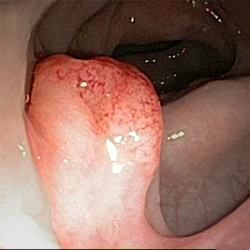
This is a picture of a "pedunculated" polyp. This polyp has a stalk beneath it. It is a large polyp which was causing the person to have bright red blood with bowel movements.
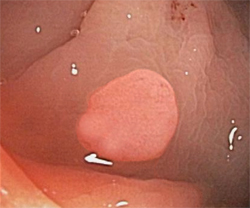
This is a picture of a flat or "sessile" polyp. These polyps can be difficult to spot if the colon is not properly cleaned.
Depending on what cells a polyp has develped from, some polyps will grow rather quickly and carry a greater risk of developing colon cancer. Any polyps removed from the colon need to be examined under a microscope to determine if they carry this increased risk. Your physician should meet with you after your colonoscopy to discuss these results.
These are some examples of polyps classified according to their cellular type:
1. Hyperplastic polyps - Low risk of developing into a colon cancer.
2. Tubular adenomas - Slightly increased risk of colon cancer.
3. Tubular-villous adenomas - More of an increased risk of colon cancer.
4. Villous adenomas - High risk of developing into colon cancer.
5. Serrated adenomas - Highest risk of developing into colon cancer.
Pictures of various polyps
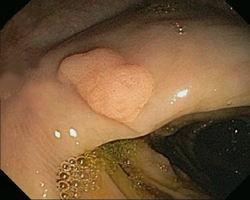
This is a flat polyp which is raised up slightly. It does not have a stalk like a "pedunculated" polyp. We would call this a "semi-sessile" polyp. After examining this polyp under a microscope, it was decided that it was a "villous adenoma". It carries a high risk of developing into colon cancer.
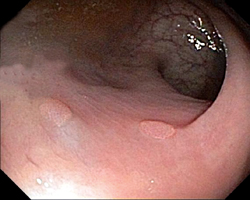
These are two small polyps. They represent "sessile", or flat, polyps which can be difficult to spot (especially if the colon has not been cleansed well). These polyps were found to be "serrated adenomas" with a high risk of developing into colon cancer.
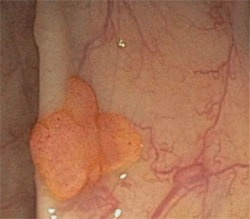
This polyp is also a "semi-sessile" polyp which was difficult to spot due to the fact that it was growing behind a fold. It was found to be a "tubular adenoma" with a lower risk of developing into colon cancer.
As you can see from the above pictures it can be difficult to determine the risk a polyp carries of developing into colon cancer from appearance alone. Only your physician can determine when you may need a repeat colonoscopy based on the type, appearance, and number of polyps found.
